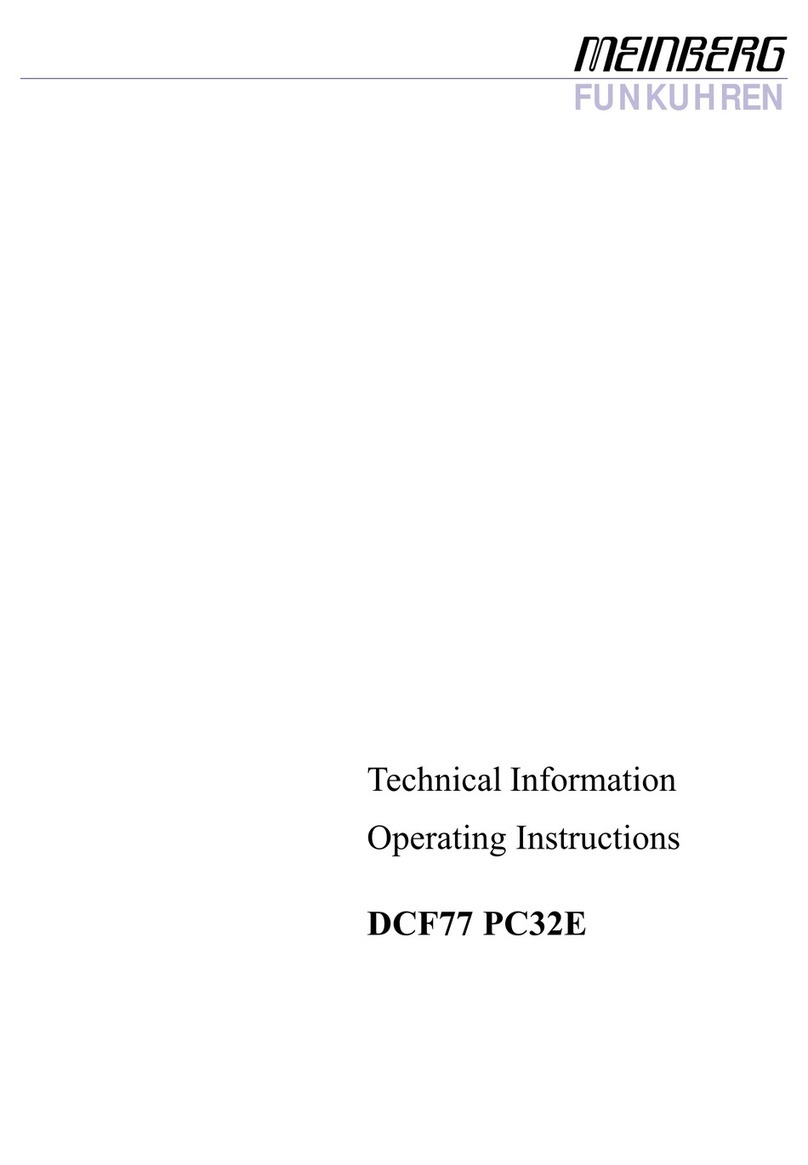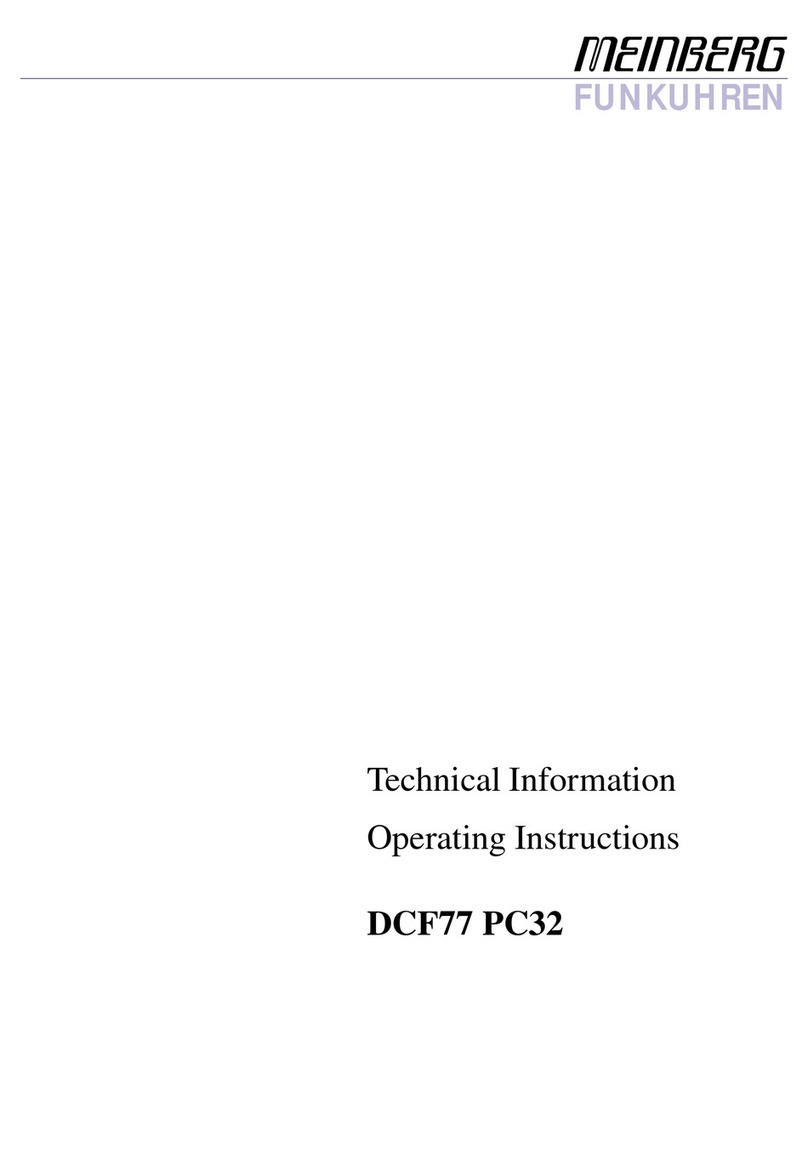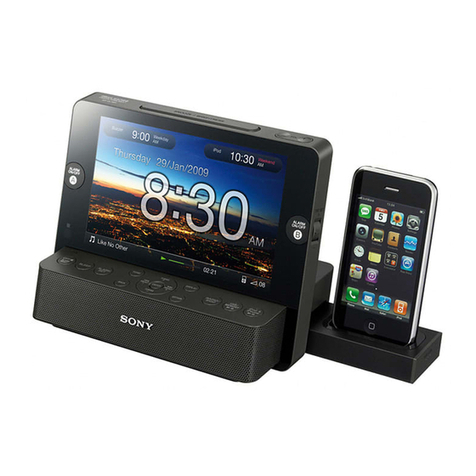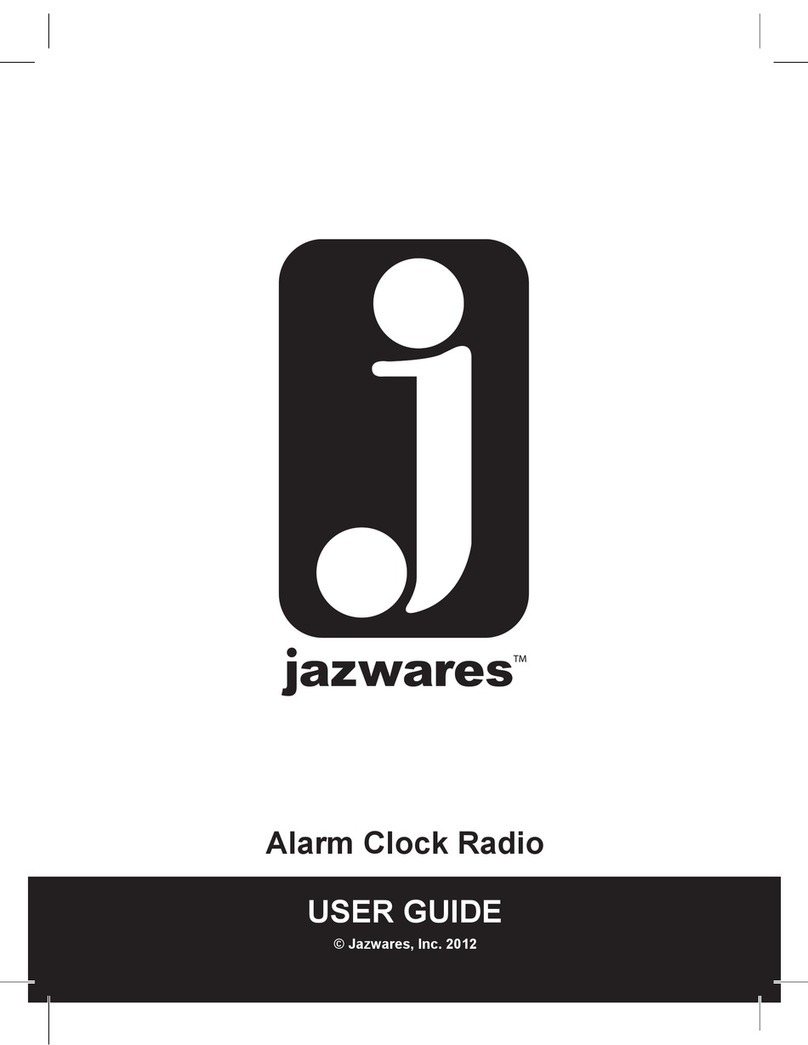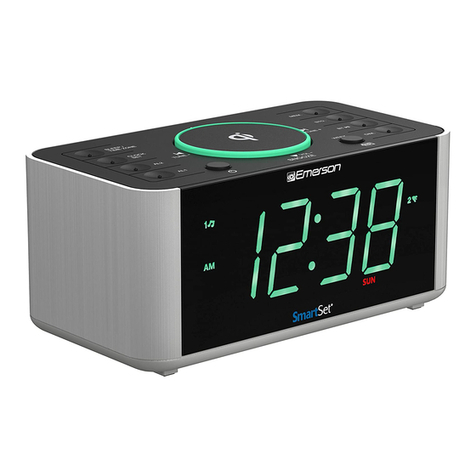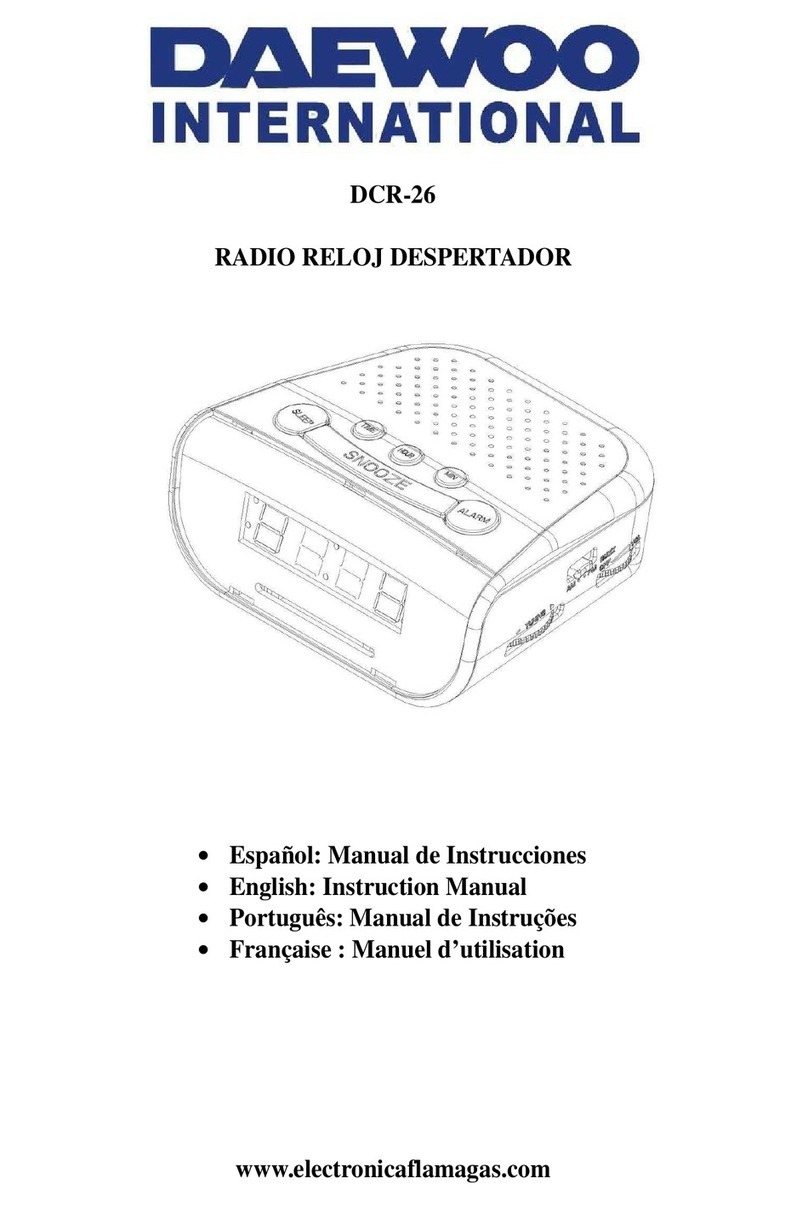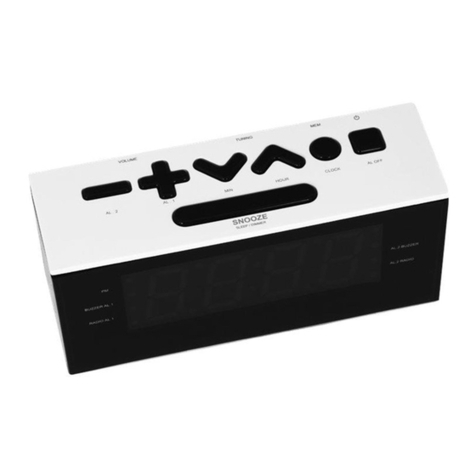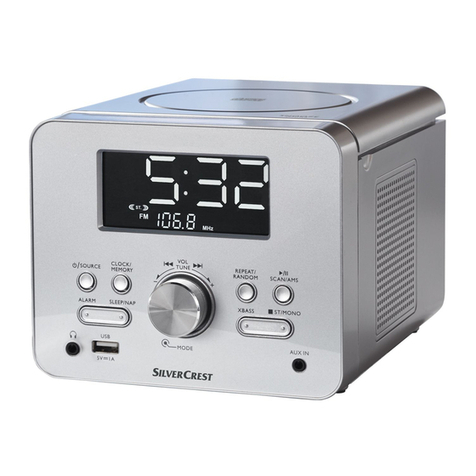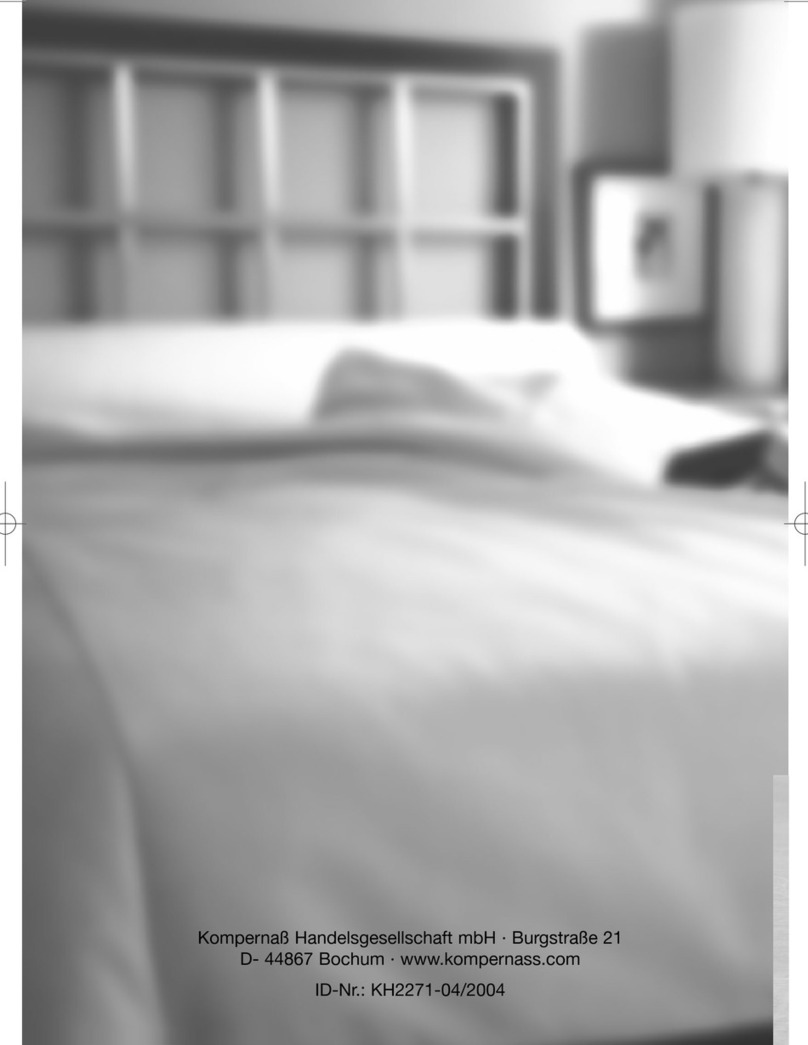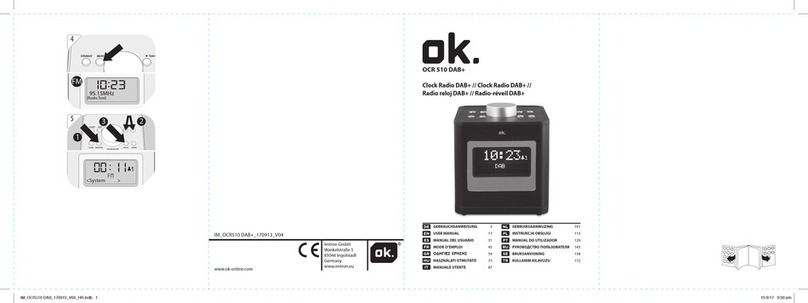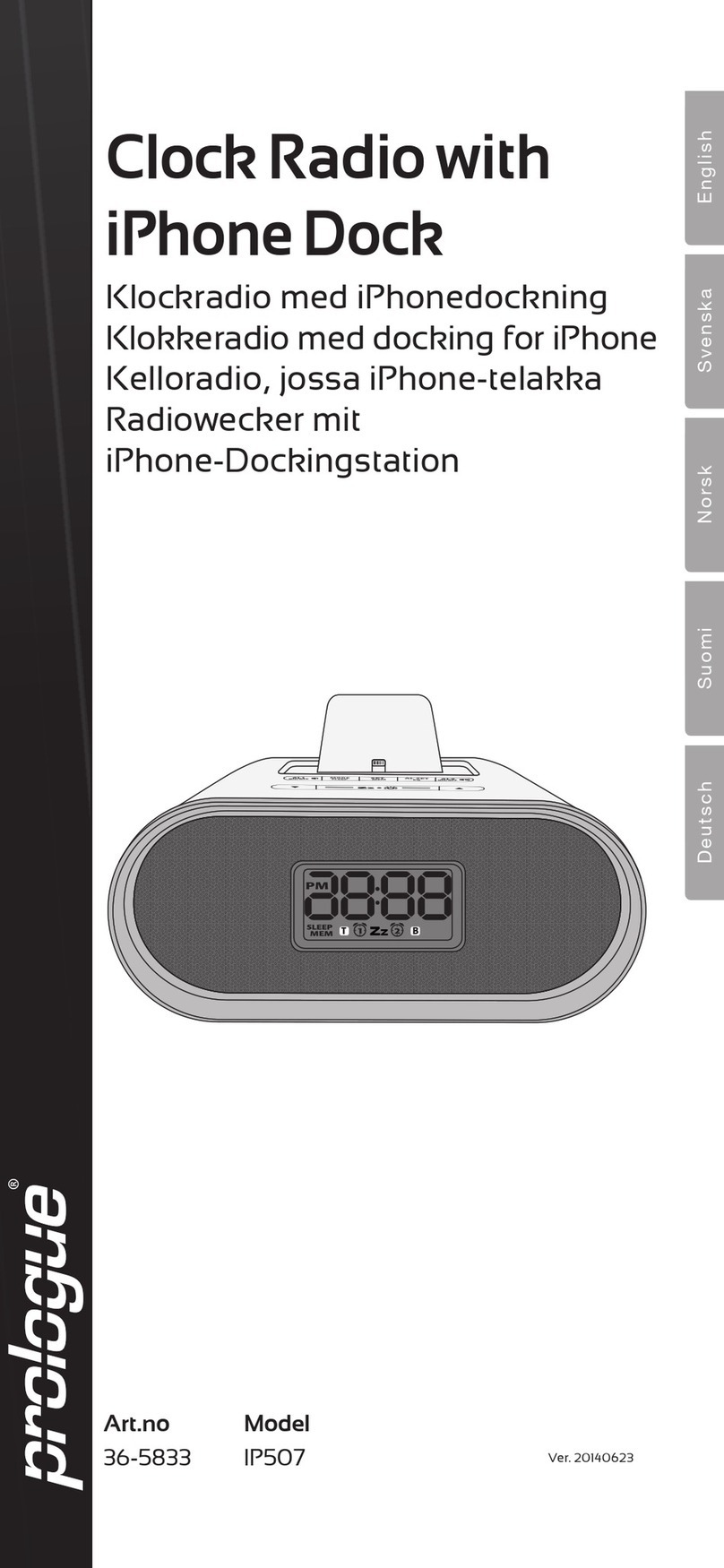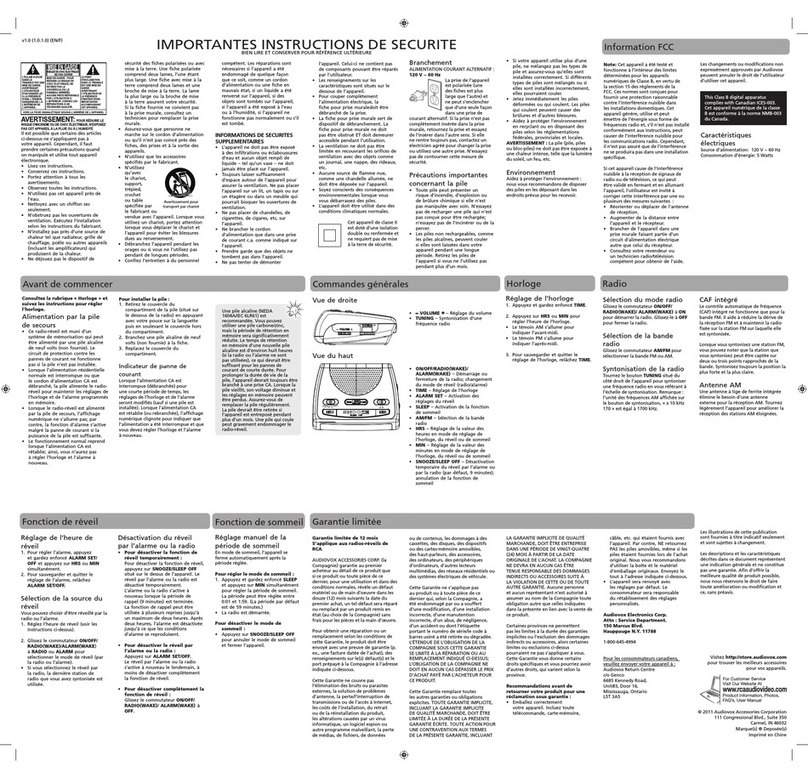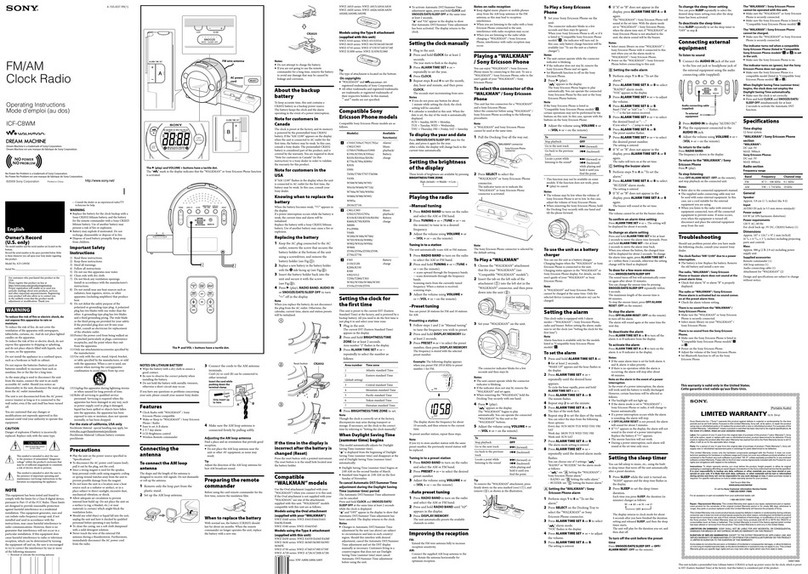Meinberg TCR180PEX User manual

MANUAL
TCR180PEX
IRIG Code controlled Radio Clock
12th August 2020
Meinberg Funkuhren GmbH & Co. KG


Table of Contents
1 Imprint 1
2 Safety instructions for building-in equipment 2
2.1 Used Symbols ................................................. 2
2.2 Safety Hints TCR180PEX .......................................... 3
2.3 Additional Safety Hints ........................................... 3
2.4 Cabling ..................................................... 4
2.5 Replacing the Lithium Battery ....................................... 4
3 TCR180PEX Features 5
4 Block diagram TCR180 6
5 Master oscillator 7
6 Functional description of receiver 8
6.1 Input signals .................................................. 11
6.2 Input impedance for modulated signals .................................. 12
6.3 Photocoupler input .............................................. 13
7 Functionality of the generator 14
7.1 Time Code Outputs .............................................. 14
7.1.1 Modulated Outputs ......................................... 14
7.1.2 Unmodulated Outputs ........................................ 14
7.2 Pulse outputs ................................................. 15
7.3 Asynchronous serial port .......................................... 16
7.4 Frequency synthesizer ............................................ 16
7.5 Enabling of outputs ............................................. 17
7.6 DCF77 Emulation .............................................. 17
7.7 Time capture inputs ............................................. 18
8 Connectors and LEDs in the bracket 19
8.1 Pin assignments of the 9pin D-SUB connector .............................. 20
8.2 D-SUB Pin Assignment of MultiRef Port ................................. 21
9 Putting into operation 22
9.1 Installing the TCR180PEX in your computer ............................... 22
9.2 Power supply ................................................. 22
9.3 Configuration of TCR180PEX ........................................ 22
10 Firmware Updates 23
11 Technical specification TCR180PEX 24
12 Technical appendix TCR180PEX 27
12.1 Abstract of Time Code ............................................ 27
12.1.1 Description of IRIG-Codes ..................................... 27
12.2 Time code Format .............................................. 28
12.2.1 IRIG Standard Format ....................................... 28
12.2.2 AFNOR Standard Format ..................................... 29
12.3 Time Strings .................................................. 30
12.3.1 Format of the Meinberg Standard Time String ......................... 30
12.3.2 Format of the Meinberg Capture String ............................. 31
12.3.3 Format of the Uni Erlangen String (NTP) ............................ 32
12.3.4 Format of the SAT Time String .................................. 34
3

12.3.5 Format of the Computime Time String .............................. 35
12.3.6 Format of the SPA Time String .................................. 36
12.3.7 Format of the RACAL standard Time String ........................... 37
12.3.8 Format of the ION Time String .................................. 38
12.4 PCI Express (PCIe) .............................................. 39
12.5 Content of the USB stick .......................................... 40
13 Declaration of Conformity 41
Date: 12th August 2020 TCR180PEX

1 Imprint
1 Imprint
Meinberg Funkuhren GmbH & Co. KG
Lange Wand 9, 31812 Bad Pyrmont / Germany
Phone: + 49 (0) 52 81 / 93 09 - 0
Fax: + 49 (0) 52 81 / 93 09 - 230
Internet: https://www.meinbergglobal.com
Mail: [email protected]
Date: 12.08.2020
TCR180PEX Date: 12th August 2020 1

2 Safety instructions for building-in equipment
2.1 Used Symbols
Nr.
Symbol
Beschreibung / Description
1
IEC 60417-5031
Gleichstrom /
Direct current
2
IEC 60417-5032
Wechselstrom /
Alternating current
3
IEC 60417-5017
Erdungsanschluss /
Earth (ground) Terminal
4
IEC 60417-5019
Schutzleiterklemme /
Protective Conductor Terminal
5
Vorsicht, Risiko eines elektrischen Schlages /
Caution, possibility of electric shock
6
ISO 7000-0434
Vorsicht, Risiko einer Gefahr /
Caution, Danger
7
2012/19/EU
Dieses Produkt fällt unter die B2B Kategorie. Zur Entsorgung
muss es an den Hersteller übergeben werden.
This product is handled as a B2B category product. In order to
secure a WEEE compliant waste disposal it has to be returned
to the manufacturer.
CE label
This device follows the provisions
of the directives 93/68/EEC
2 Date: 12th August 2020 TCR180PEX

2 Safety instructions for building-in equipment
2.2 Safety Hints TCR180PEX
This building-in equipment has been designed and tested in accordance with the requirements of Standard
IEC60950-1 "Safety of Information Technology Equipment, including Electrical Business Equipment".
During installation of the building-in equipment in an end application (i.e. PC) additional requirements in
accordance with Standard IEC60950-1 have to be taken into account.
General Safety instructions
•The building-in equipment has been evaluated for use in office environment (pollution degree 2) and
may be only used in this environment. For use in rooms with a higher pollution degree more stringent
requirements are applicable.
•The equipment/building-in equipment was evaluated for use in a maximum ambient temperature of 50◦C.
•Protection against fire must be assured in the end application.
2.3 Additional Safety Hints
This manual contains important information for the installation and operation of this device as well as for your
safety. Make sure to read carefully before installing and commissioning the device.
Certain operating conditions may require the observance of additional safety regulations not covered by this
manual. Nonobservance of this manual will lead to a significant abatement of the security provided by this
device. Security of the facility where this product is integrated lies in the responsibility of the installer.
The device must be used only for purpose named in this manual, any other use especially opteration above the
limits specified in this document is considered as improper use.
Keep all documents provided with the device for later reference.
This manual is exclusively for qualified electricians or by a qualified electrician trained personnel who are
familiar with the applicable national standards and specifications, in particular for the construction of high
voltage devices.
TCR180PEX Date: 12th August 2020 3

2.4 Cabling
WARNING!
DANGER TO LIFE BY ELECTRICAL SHOCK! NO LIVE WORKING!
Wiring or any other work done the connectors particularly when connectors are opened may never be carried out
when the installation is energized. All connectors must be covered to prevent from accidental contact to life parts.
ALWAYS ENSURE A PROPER INSTALLATION!
2.5 Replacing the Lithium Battery
Skilled/Service-Personnel only: Replacing the Lithium Battery
The life time of the lithium battery on the receiver boards is at least 10 years. If the need arises to replace the
battery, the following should be noted:
There is a Danger of explosion if the lithium battery is replaced incorrectly. Only identical batteries or
batteries recommended by the manufacturer must be used for replacement.
The waste battery has to be disposed as proposed by the manufacturer of the battery.
4 Date: 12th August 2020 TCR180PEX

3 TCR180PEX Features
3 TCR180PEX Features
The board TCR180PEX has been designed as a "low profile" board for computers with PCI Express interface.
Data transfer to the computer is done via a single PCI Express lane (x1 board). The TCR180PEX card decodes
and generates modulated (AM) and unmodulated (DC Level Shift, DCLS) IRIG-A/B/G, AFNOR NF S87-500,
IEEE C37.118, or IEEE 1344 time codes. AM codes are transmitted by modulating the amplitude of a sine wave
carrier, unmodulated codes by variation of the width of pulses.
The TCR180PEX is equipped with a high quality oscillator which is disciplined as log as an input signal
is available, and provides accurate time in holdover mode if the input signal is disconnected.
Receiver:
Automatic gain control within the receive circuit for unmodulated codes allows decoding of IRIG-A/B/G, AFNOR
NF S87-500, IEEE C37.118 or IEEE 1344 signals with a carrier amplitude of 600 mVpp to 8 Vpp. The input
stage is electrically insulated and has an impedance of either 50 Ω, 600 Ωor 5 kΩ, selectable by a jumper.
Modulated input signals can be supplied via BNC connector in the TCR180PEX’s bracket.
Unmodulated (DC Level Shift, DCLS) time codes have to supplied via the card’s 9 pin D-Sub connector. The
receive circuit is insulated by an onboard photocoupler which can be driven by TTL or RS-422 signals for
example. When the card is shipped the contacts of the D-Sub connector are not wired to the photocoupler. Two
DIP switches have to be set to the ‘ON’ position to make the inputs available via the connector.
Generator:
The time code output of the TCR180PEX can generate time codes in IRIG-A/B/G, AFNOR NF S87-500, IEEE
C37.118, or IEEE 1344 format. The output signal is available as modulated (3 Vpp / 1 Vpp into 50 Ω) and
unmodulated (DC Level Shift, DCLS) signal (TTL into 50 Ωand RS-422). A jumper on the board allows selection
of active-high or active-low DCLS output.
Format and UTC offset of the incoming and outgoing time codes can be configured independently, so the
TCR180PEX is well-suited for time code conversion.
Optionally the TCR180PEX can be delivered with optical inputs/outputs. The card provides two configurable
serial interfaces (RS-232) COM. COM0 is available via the Sub-D connector, COM1 is accessible via an extra
ribbon cable connector on the board. Three programmable pulse outputs are available via the D-Sub connector
by setting appropriate DIP switches to the ‘ON’ position.
The extra ribbon cable connector on the board also provides two TTL inputs (CAP0 and CAP1) that can
be used to time stamp external, asynchronous trigger slopes. The captured time stamps can be retrieved via the
PCI-bus, or can be emitted as ASCII string via one of the serial interfaces.
TCR180PEX provides a synthesizer which can generate output frequencies from 1/8 Hz up to 10 MHz with
TTL level into 50 Ωas a sine wave signal.
TCR180PEX Date: 12th August 2020 5

4 Block diagram TCR180
PCI Express
interface
RS232
drivers
driver
circuits
10MHz, TTL
programmable pulses
time capture CAP0/CAP1
unmodulated timecode
TTL into 50 Ω
microcontroller
with RTC and
Flash EPROM
master
oscillator
Frequency
Synthesizer
D/A-converter
and driver
FPGA
programmable
logic
Time Code
generator
SRAM
data memory
internal power
clock
control
voltage addr/data
addr/data/control
dual Tx/Rx
PCI Express bus
power
RS232 COM 0 / COM 1
modulated timecode
Tx Rx Refclk
photocoupler
AGC-circuit and
pulse shaper
TC-AM F_SYNTH
fiber optic
receiver
(option)
data
fiber optic
transmitter
unmodulated time code
optical output (option)
modulated timecode input
unmodulated timecode input
unmodulated timecode
optical input (option)
6 Date: 12th August 2020 TCR180PEX

5 Master oscillator
5 Master oscillator
By default the TCR180PEX is equipped with a TCXO (Temperature Compensated Xtal Oscillator) as master
oscillator to provide a good time accuracy and frequency stability. As long as an input signal is supplied the
frequency of the oscillator is adjusted from the input signal, and if the input signal is disconnected afterwards
the card can still provide accurate time for a certain holdover interval. Optionally the card can be ordered with
an OCXO (Oven Controlled Xtal Oscillator) which provides even better frequency stability, and thus provides
more accuracy over a longer holdover interval than the TCXO.
All internal timing as well as the output signals are derived from the oscillator. The last known good os-
cillator adjustment value is stored in non-volatile memory, and is used as default after power-up.
The oscillator’s 10 MHz output frequency is also available with TTL level via at a ribbon cable connector.
TCR180PEX with OCXO-HQ Oscillator
TCR180PEX Date: 12th August 2020 7

6 Functional description of receiver
After the received time code has passed a consistency check, the TCR180PEX’s on-board software clock and
battery buffered real time clock are synchronized according to the external time reference. If an error or incon-
sistency is detected in subsequent time code frames, or the input signal is disconnected, the on-board clock
switches to holdover mode, where the time is derived from the on-board high quality oscillator which has been
disciplined before.
All IRIG and similar time codes provide the time-of-day, and a day-of-year number (1...365/366). When con-
verting the day-of-year number from the incoming time code to a calendar date then the result is ambiguous
unless the year number is not known: the day after February 28 can be March 1, but can also be February 29
in case the year is a leap year.
Unfortunately, most of the commonly used IRIG code formats don’t include a year number, in which case
the year number used for the computation of the calendar date is retrieved from the battery buffered on-board
real time clock.
So care must be taken that the on-board clock has been set to the correct date. The on-board date and
time can be adjusted by sending a Meinberg Standard Time string to the serial interface COM0, or via the PCI
bus by using the utility programs included in the driver software package.
If the configured time code format does provide a year number (e.g. IEEE 1344, IEEE C37.118, IRIG-Bxx6/Bxx7)
then the year number from the time code is used instead of the year number from the on-board real time clock,
and the on-board date is set accordingly.
Most of the commonly used IRIG code formats also
don’t provide an indicator whether the transported
time is UTC, or local time with some offset from UTC.
However, the TCR180PEX always needs to derive UTC
time from the incoming time code since the card’s on-
board time is expected to run on UTC.
If no UTC offset is provided by the time code then a UTC offset parameter on the card first needs to be
configured, depending on the time provided by the input signal. When the TCR180PEX is shipped then the
UTC parameter is set to "unconfigured", and as long as this is the case the card doesn’t synchronize to the input
signal. So the UTC offset has to be configured first when the card is put into operation. The tools that come
with the driver software package given an appropriate hint if this is the case.
Only if the used time code format provides the UTC offset (e.g. IEEE 1344, IEEE C37.118) the card uses
the UTC offset from the time code, and thus even synchronizes to the input signal if the card’s UTC parameter
is still set to "unconfigured".
Care must be taken, however, if one of the IEEE 1344 or IEEE C37.118 codes is used: The main differ-
ence between these formats is the way the UTC offset is to be applied: subtracted or added. Unfortunately
there are 3rd party IRIG devices out there which claim to use a IEEE 1344 code, but in fact handle the
UTC offset as specified in IEEE C37.118. This may result in a wrong UTC time derived from the time code
if local time is transported. A simple fix is usually to switch the card from one of the IEEE codes to the other one.
The TCR180PEX can automatically convert its on-board UTC time to some local time, including automatic
8 Date: 12th August 2020 TCR180PEX

6 Functional description of receiver
switching to and from DST year by year according to configurable rules. This is independent from the UTC
offset of the incoming time code. The derived local time can be transmitted via the outgoing time code, the
serial time strings, or can be read via the PCI interface.
The time zone is entered as offset of seconds from UTC, e.g. for Germany:
MEZ = UTC + 3600 sec, MESZ = UTC + 7200 sec
The specific date of beginning and end of daylight saving can be generated automatically for several years.
The receiver calculates the switching times using a simple scheme, e.g. for Germany:
Beginning of daylight saving is the first sunday after March, 25th at two o’clock => MESZ
End of daylight saving is the first sunday after October, 25th at three o’clock => MEZ
The parameters for time zone and switching to/from daylight saving can be set by using the included mon-
itor program. If the same values for beginning and end of daylight saving are entered then no switching to DST
is made.
The associated settings can be changed using the configuration software shipped with the driver packages.
Most IRIG codes don’t include an announcement flag
for the DST change, or for the for the insertion of a
leap second, so the TCR180PEX will switch into free
wheeling mode on such event, and resynchronize a few
seconds later.
TCR180PEX Date: 12th August 2020 9

The board TCR180PEX decodes the following formats:
Please note: all "A" und "G" Timecodes are only available after warmed up phase of the oscillator!
A002: 1000pps, DC Level Shift pulse width coded, no carrier
BCD time of year
A132: 1000pps, amplitude modulated sine wave signal, 10 kHz carrier frequency
BCD time of year
A003: 1000pps, DC Level Shift pulse width coded, no carrier
BCD time of year, SBS time of day
A133: 1000pps, amplitude modulated sine wave signal, 10 kHz carrier frequency
BCD time of year, SBS time of day
B002: 100pps, DC Level Shift pulse width coded, no carrier
BCD time of year
B122: 100pps, amplitude modulated sine wave signal, 1 kHz carrier frequency
BCD time of year
B003: 100pps,DC Level Shift pulse width coded, no carrier
BCD time of year, SBS time of day
B123: 100pps, amplitude modulated sine wave signal, 1 kHz carrier frequency
BCD time of year, SBS time of day
B006: 100 pps, DC Level Shift, no carrier
BCD time-of-year, Year
B126: 100 pps, AM sine wave signal, 1 kHz carrier frequency
BCD time-of-year, Year
B007: 100 pps, DC Level Shift, no carrier
BCD time-of-year, Year, SBS time-of-day
B127: 100 pps, AM sine wave signal, 1 kHz carrier frequency
BCD time-of-year, Year, SBS time-of-day
G002: 10 k pps, DC Level Shift, no carrier
BCD time-of-year
G142: 10 k pps, AM sine wave signal, 100 kHz carrier frequency
BCD time-of-year
G006: 10 k pps, DC Level Shift, no carrier
BCD time-of-year, Year
G146: 10 k pps, AM sine wave signal, 100 kHz carrier frequency
BCD time-of-year, Year
10 Date: 12th August 2020 TCR180PEX

6 Functional description of receiver
AFNOR: Code according to NF S-87500, 100 pps, wave signal,
1kHz carrier frequency, BCD time-of-year, complete date,
SBS time-of-day, Signal level according to NF S-87500
IEEE 1344: Code according to IEEE 1344-1995, 100 pps, AM sine wave signal,
1kHz carrier frequency, BCD time-of-year, SBS time-of-day,
IEEE 1344 extensions for date, timezone, daylight saving and
leap second in control functions (CF) segment.
(also see table ’Assignment of CF segment in IEEE 1344 mode’)
IEEE C37.118: Like IEEE 1344 - with UTC offset to be applied reversely
6.1 Input signals
The time code format has to be configured using the monitor software: if an amplitude-modulated signal (IRIG-
A/B/G, AFNOR NF S-87500, IEEE C37.118 oder IEEE 1344) is configured then the input signal has to be
supplied to the upper BNC connector in the TCR180PEX’s bracket. A coaxial, shielded or twistet pair cable
should be used.
A pulse width modulated (DC Level Shift, DCLS) signal has to be supplied via the 9-pin D-SUB connec-
tor. Two DIP switches have to be set to the "ON" position to wire the contacts of the D-Sub connector to
the onboard photocoupler, and an appropriate DCLS time code format has to be configured using the monitor
program.
Optionally an optical input can be equipped instead of the modulated input. It is available as ST-connector for
GI 50/125 µm or GI 62,5/125 µm gradient fiber.
The board TCR180PEX can’t be used to decode am-
plitude modulated and DC Level Shift signals simul-
taneously. Depending on the selected code format,
only the signal at the BNC-connector or the D-Sub
connector is decoded.
TCR180PEX Date: 12th August 2020 11

6.2 Input impedance for modulated signals
Except the AFNOR NF S87-500 standard there are no time code specifications for modulated signals which
define the output impedance of a generator, or the input impedance of a receiver, so care must be taken that
the specifications of this card meet the requirements of 3rd party devices.
The TCR180PEX provides a jumper to set the input impedance for modulated codes to 50 Ω, 600 Ω,
or 5 kΩ.
Time code outputs provided by Meinberg devices provide a 50 Ωoutput impedance to match the transmis-
sion requirements with coaxial cable, so the receiver should be set to 50 Ωinput impedance if only a single
receiver is connected to a generator.
If T-connectors are used to provide several receivers with a single output signal from a generator then the
resulting load impedance for the generator may be too low if all receivers have a low input impedance, so it’s
more appropriate to set the input impedance of all receivers to 600 Ω. This also meets the requirement of the
AFNOR standard, so this is the default setting when the TCR180PEX is shipped.
Only if the external time code generator has a high output impedance (see specifications of the external time
code generator) it may be required to set the input impedance to 5 kΩ.
The driver software shows a bar chart for evaluation of the signal level at the receiver input. The following
detail of the TCR180PEX’s placeplan of shows the possible jumper settings and the associated input impedance:
no Jumper: 5 kΩ
12 Date: 12th August 2020 TCR180PEX

6 Functional description of receiver
6.3 Photocoupler input
Pulse width modulated (DC Level Shift) codes are insulated by an onboard photocoupler. The connection
scheme is shown below:
R = 220 Ohm
DIP 3
DIP 2
+ DCLS in
- DCLS in
MultiRef-Port: Pin Assignment of the D-SUB 9 connecor
(see chapter D-SUB Pin Assignment of MultiRef Port )
The internal series resistance allows direct connection of input signals with a maximum high level of +12
V (TTL or RS-422 for example). If signals with a higher amplitude are used, an additional external series
resistance has to be applied to not exceed the limit of the forward current of the input diode (60 mA). The
forward current should not be limited to a value of less than 10 mA to ensure safe switching of the photocoupler.
TCR180PEX Date: 12th August 2020 13

7 Functionality of the generator
The time code generator of TCR180PEX is based on a DDS (Direct Digital Synthesis) frequency generator
which derives the sine carrier of the modulated code from the reference clock of the master oscillator. The
modulation of carrier amplitude (modulated codes) or pulse duration (unmodulated, DC level shift codes) is
synchronized to the generated pulse-per-second (PPS) signalderived from the software clock.
The generated time code is independent from the set-
tings for the received code. Thus it’s possible to gen-
erate a output signal with a different format and UTC
offset than the input signal.
7.1 Time Code Outputs
TCR180PEX provides modulated and unmodulated (DC level shift) outputs. As an option, an optical output can
be equipped instead of the modulated output. It is available as ST-connector for GI 50/125µm or GI 62,5/125µm
gradient fiber.
7.1.1 Modulated Outputs
The amplitude-modulated sine carrier is available a BNC-coaxial-plug connector in the bracket. The signal
amplitude is 3Vpp (MARK) and 1Vpp (SPACE) into 50 Ohm. The encoding is made by the number of MARK-
amplitudes during ten carrier waves. The following agreements are valid:
binary ’0’ : 2 Mark - amplitudes, 8 SPACE-amplitudes
binary ’1’ : 5 Mark - amplitudes, 5 SPACE-amplitudes
position-identifier : 8 Mark - amplitudes, 2 SPACE-amplitudes
7.1.2 Unmodulated Outputs
The pulse width modulated DC-signals are coexistent to the modulated output and are available with TTL
level into 50 Ohm and as RS-422 signal. After bringing DIP-switches into the ’ON’ position, these outputs are
available at the D-Sub connector. The active state of the unmodulated outputs can be set up by a jumper on
the board TCR180PEX
14 Date: 12th August 2020 TCR180PEX

7 Functionality of the generator
7.2 Pulse outputs
The pulse generator of TCR180PEX provide three independent channels (PPO0, PPO1, PPO2). All of these
TTL outputs can be mapped to pins at the 9-pin connector at the rear slot cover by using a DIP switch. Each
output can be switched according to different, predefined conditions. The pulse length can be configured from
10 msec to 10 sec in steps of 10 msec. The output signal level can be inverted, if required.
By default when shipped the pulse outputs are only enabled after the receiver has synchronized after power-up.
However, the settings can be changed so that outputs are always enabled immediately after power-up. The
pulse outputs can be configured using the monitor program shipped with the driver software package. The
following modes can be configured independently for each channel:
Timer mode: Three "on" and "off" time pairs per day
Cyclic mode: Periodically repeated pulses.
A cycle time of two seconds would generate a pulse at
0:00:00, 0:00:02, 0:00:04 etc.
DCF77-Simulation:
mode: Outputs simulated DCF77-compüatible time marks,
representing the local time configured on the device.
Single Shot Mode: A single pulse of programmable length is generated once a day at a
programmable point of time.
Per Sec.
Per Min.
Per Hr. modes: Pulses once per second, minute, or hour aligned with second boundary
Synthesizer: Frequency output 1/8 Hz up to 10 MHz
Time Codes: Generation of Time Codes as described in chapter "Time Codes"
Idle-mode: The output is inactive
The default configuration for the pulse outputs is:
PPO0: Pulse each second (PPS), active HIGH, pulse duration 200 msec
PPO1: Pulse each minute (PPM), active HIGH, pulse duration 200 msec
PPO2: DCF77 Simulation
TCR180PEX Date: 12th August 2020 15

7.3 Asynchronous serial port
Two asynchronous serial interfaces (RS-232) labelled COM0 and COM1 are provided by the TCR180PEX. Only
COM0 is available at the rear panel slot cover, COM1 is accessible via the second ribbon cable connector on
the card. The monitor program can be used to configure the outputs. In the default mode of operation, the serial
outputs are disabled until the receiver has synchronized after power-up. However, they can be configured to be
enabled immediately after power-up.
Transmission speed, framing and mode of operation can be configured individually for each port. Both of
the ports can be configured to transmit either time strings (once per second, once per minute, or on request with
ASCII "?" only), or to transmit capture strings (automatically when available, or on request). The format of the
output strings is ASCII, see the technical specifications at the end of this document for details.
Please note: If a serial interface sends capture events
automatically, they can’t be read via PCI-bus, because
they are deleted from the buffer memory after trans-
mission.
7.4 Frequency synthesizer
The frequency synthesizer can generate output frequencies of 1/8 Hz up to 10 MHz as sine wave signal and
with TTL-level into 50 Ohm. If a frequency below 1 kHz has been selected the following decimal places lead
to real fractions of Hertz:
0.1 1/8 Hz
0.3 1/3 Hz
0.6 2/3 Hz
The synthesizer is turned off if a frequency of 0 Hz is configured.
If the output frequency is below 10 kHz the phase of the output signal can be set from -360◦to +360◦with a
resolution of 0.1◦.
16 Date: 12th August 2020 TCR180PEX
Table of contents
Other Meinberg Clock Radio manuals

Meinberg
Meinberg DCF77 UA509 User manual
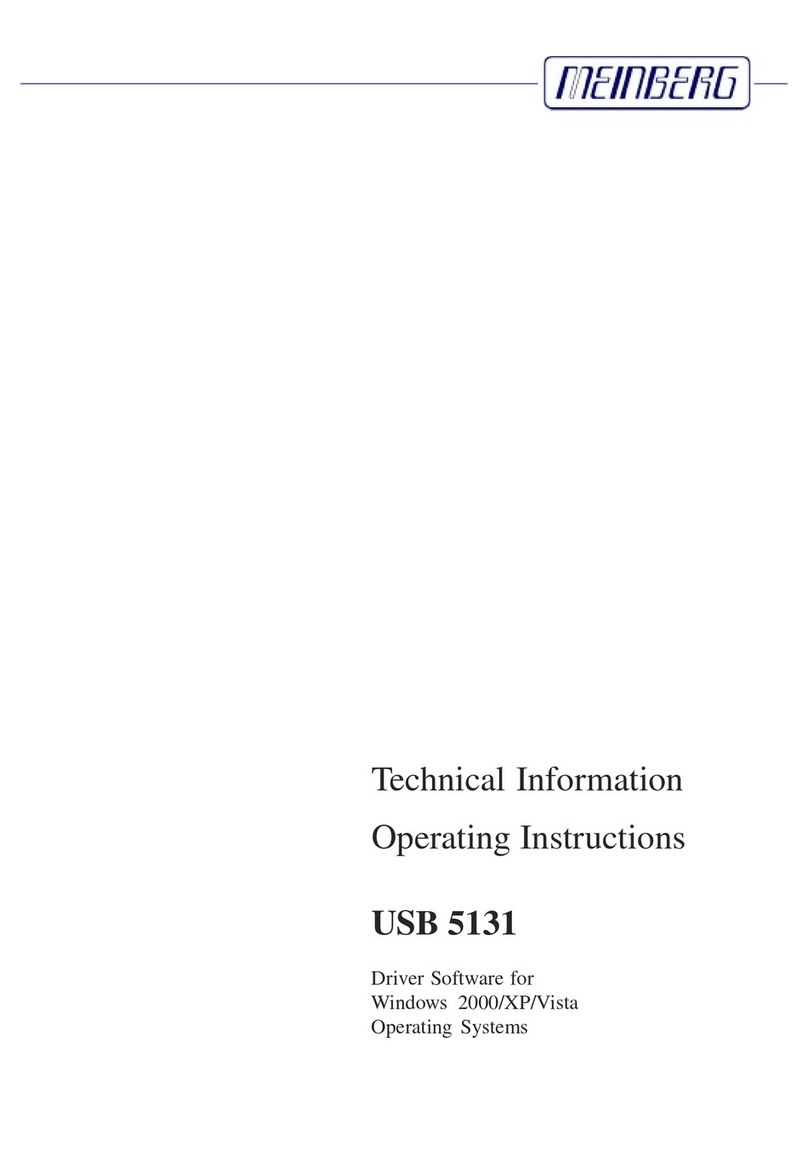
Meinberg
Meinberg USB 5131 User manual

Meinberg
Meinberg VME31 User manual

Meinberg
Meinberg USB 5131 User manual
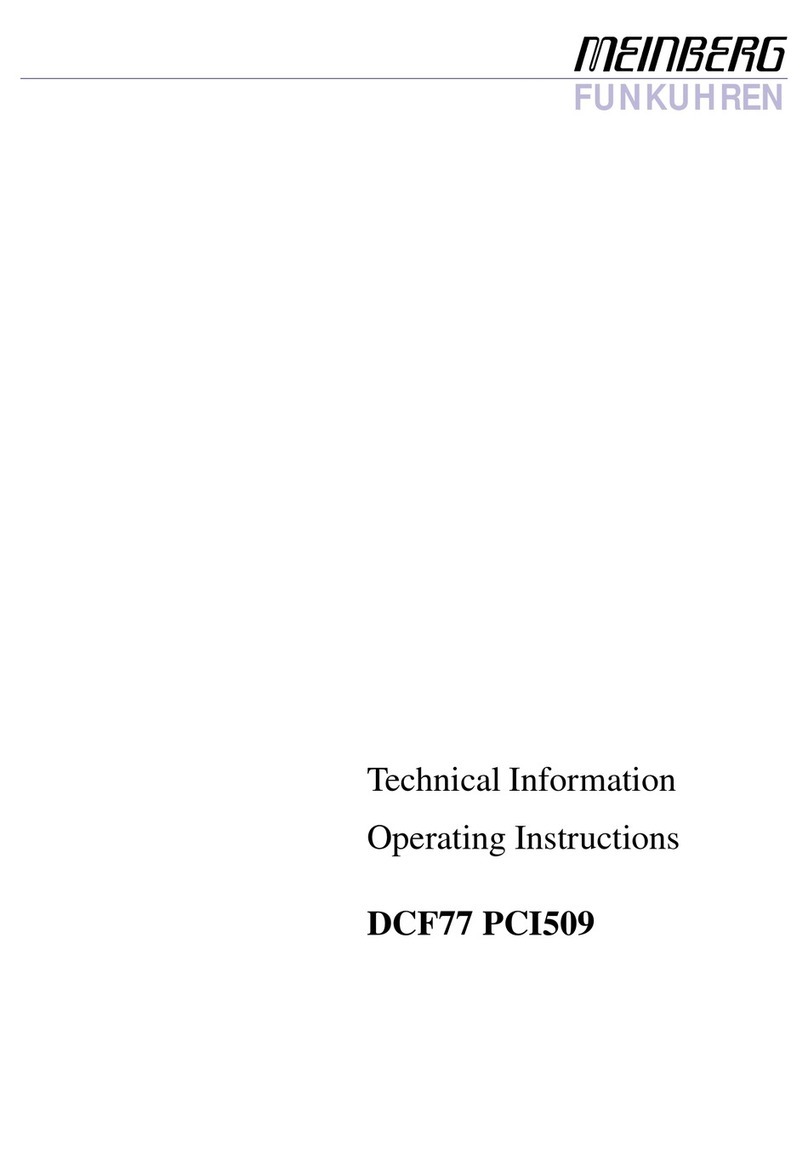
Meinberg
Meinberg DCF77 PCI509 User manual

Meinberg
Meinberg DCF77 PCI32 User manual
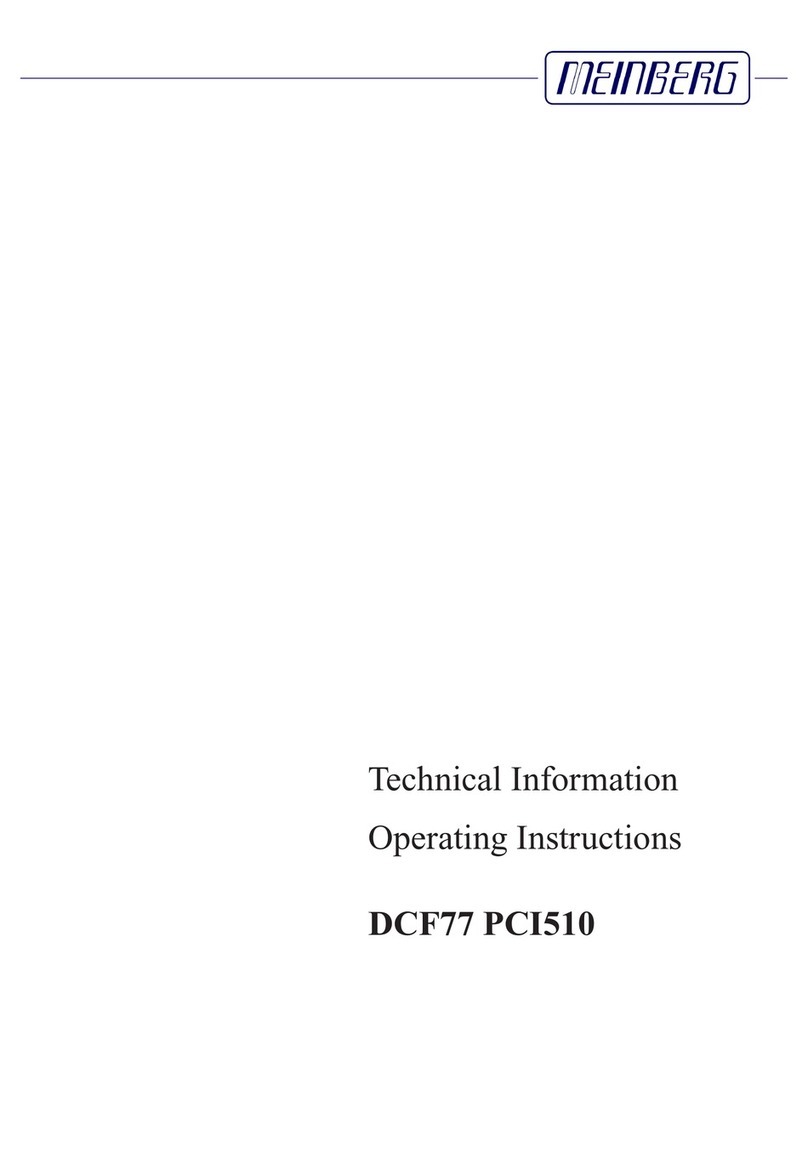
Meinberg
Meinberg DCF77 PCI510 User manual

Meinberg
Meinberg UA32S User manual
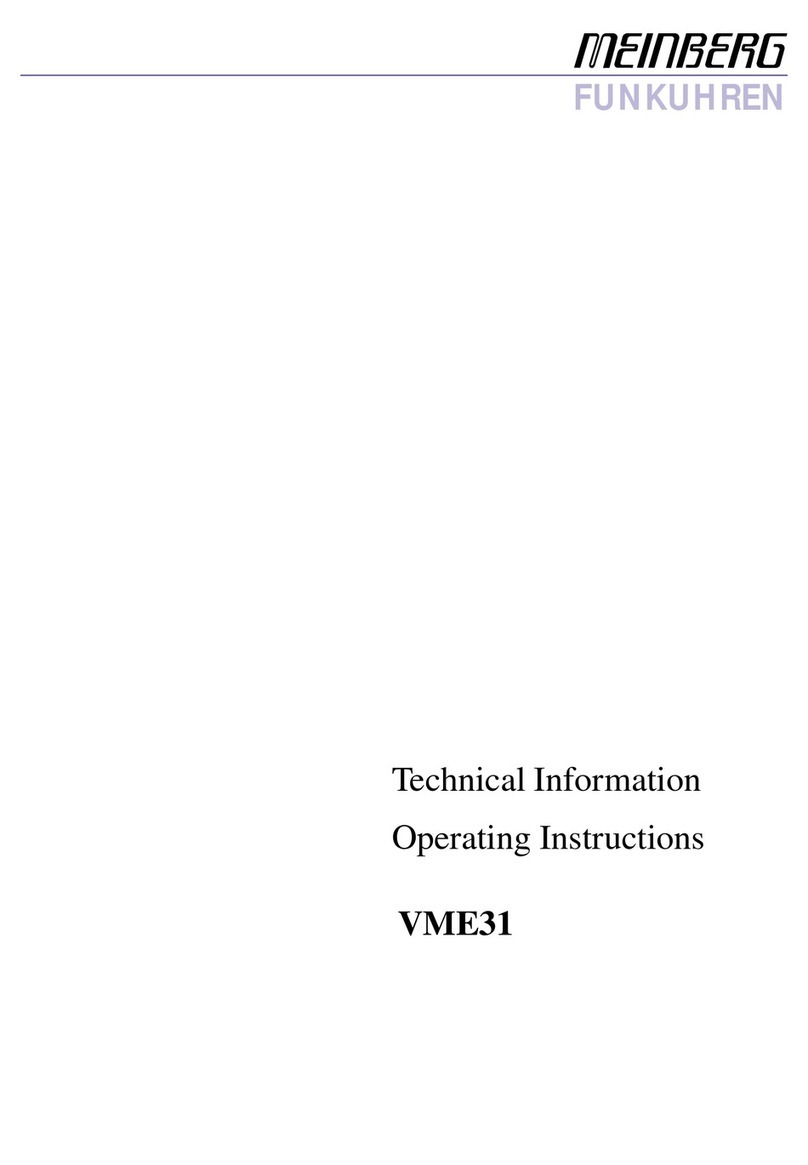
Meinberg
Meinberg VME31 User manual

Meinberg
Meinberg ANZ14 User manual
